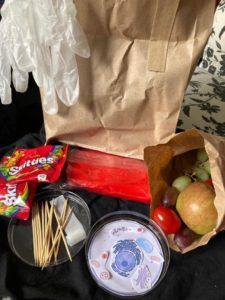Written by Cristina Escribano Gonzalez
 A month ago, Himani Rana and I delivered a ‘Cell Culture’ activity as part of a series of interactive workshops set up by the IMSR Community Action Team (CAT). This particular workshop also involved another CAT member, Daniela Nasteska, who participated and ran her ‘Build an Islet’ activity. We were very excited to be able to get some hands-on experience in school engagement, even if it was remotely due to COVID restrictions.
A month ago, Himani Rana and I delivered a ‘Cell Culture’ activity as part of a series of interactive workshops set up by the IMSR Community Action Team (CAT). This particular workshop also involved another CAT member, Daniela Nasteska, who participated and ran her ‘Build an Islet’ activity. We were very excited to be able to get some hands-on experience in school engagement, even if it was remotely due to COVID restrictions.
We had spent some time thinking about what was the best way to introduce our work and to involve such a young audience (Year 3 and 4), while keeping the activity interesting and informative.
We initially joint the Community Action Team wanting to get some experience in engagement and to interact with young students to motivate and encourage interest in STEM subjects. We were kindly welcomed to the team and it was great to get to know more about other IMSR researchers’ activities and goals, that we might have not interacted with otherwise – even though we are all part of the same institute, the IMSR has so many different groups!
With the ambitious goal of organising an IMSR festival in the next 4 months, we started to get ideas of what kind of activities and talks we could organise which would be interesting for the community. This is how the Cell Culture activity was created. As part of the Tennant group, Himani and myself use cell cultures daily for most of our experiments. The initial idea was to showcase a bit of our daily routine in the lab, so the children could see how cells and experiments are prepared in a real set up.
We prepared a collage crafting activity to introduce the cells, why we use them a
nd what is inside a cell that is important for our studies. Each child received their own pack with all the supplies needed to take part in our and Daniela’s activities (Figure 1). The children followed along with us live on the day and they really enjoyed learning about the different organelles, building their own cell model using paper collage and a real petri dish they could take home! They had plenty of questions and brilliant ideas when we asked them what super power they would like a cell to have. We also recorded a video of part of our routine in the lab, so they could see what our lab and work looks like, and they were very interested in our cell culture cabinets, incubators and microscopes.
We also recorded a video of part of our routine in the lab, so they could see what our lab and work looks like, and they were very interested in our cell culture cabinets, incubators and microscopes.
Himani and I also prepared some other activities to show them what different types of cells look like, depending which tissue they belong to, which included a fun quiz. Unfortunately, we didn’t have enough time to deliver them in this session, but both the children and teachers were keen on repeating the experience sometime soon, so we hope to get to run that bit in the future!
We loved the challenge of designing and creating activities related to science and our work, which explained in an easy, understandable way what we do in the lab and why is so important for everyone to be involved. From researchers to patients and the wider community, participating in trials, providing samples for research, interacting and volunteering with charities and breaking down old myths about research, disease and cancer.
We also got to practice our own public engagement skills and hopefully helped inspire a few more young people to be curious about and interested in science! If you have ideas for schools activities you’d like to try, contact CAT – we’d love to hear about it!
